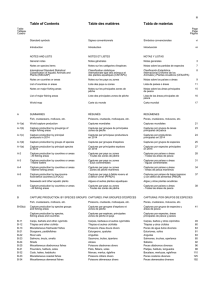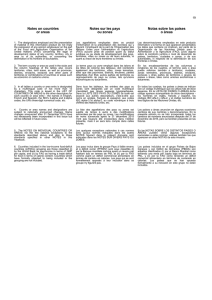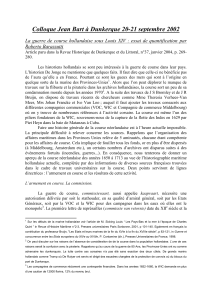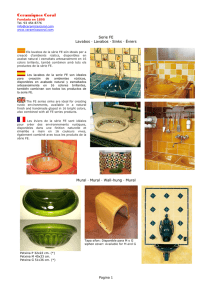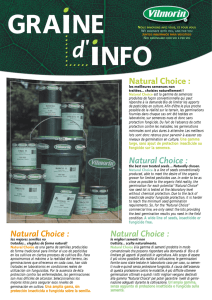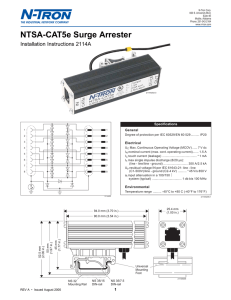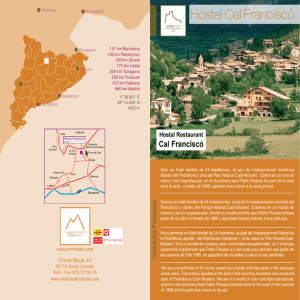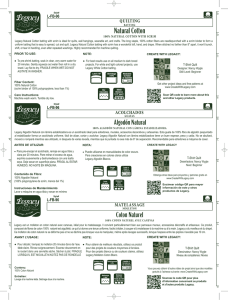NORTH AMERICAN COMMITTEE ON COOPERATION FOR
Anuncio
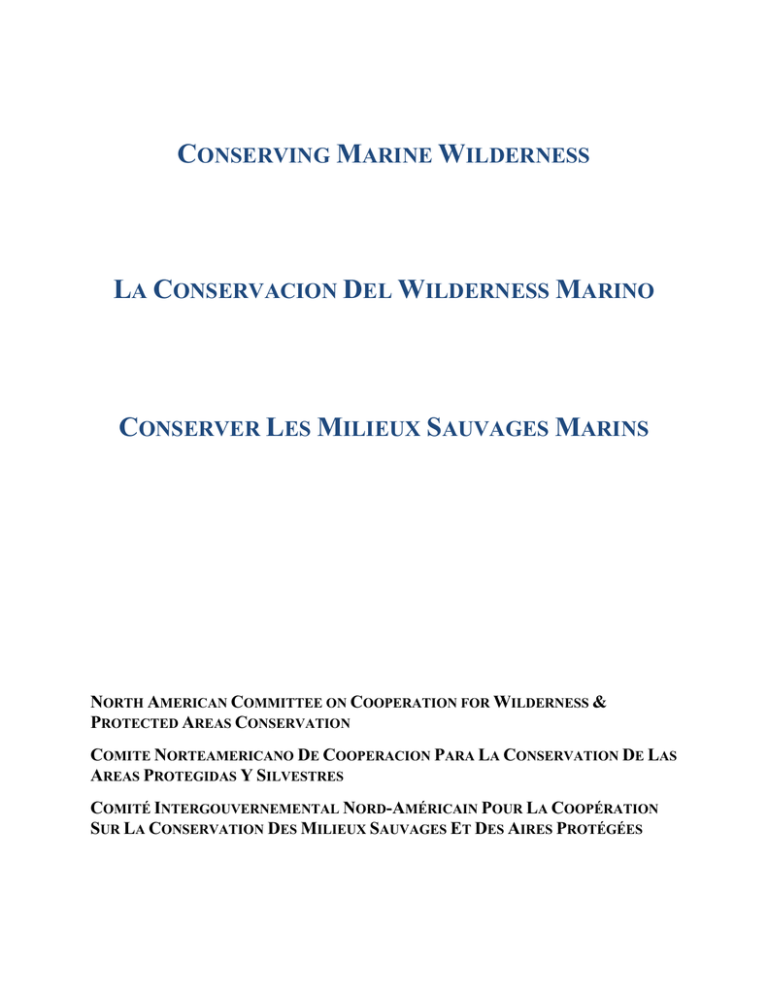
CONSERVING MARINE WILDERNESS LA CONSERVACION DEL WILDERNESS MARINO CONSERVER LES MILIEUX SAUVAGES MARINS NORTH AMERICAN COMMITTEE ON COOPERATION FOR WILDERNESS & PROTECTED AREAS CONSERVATION COMITE NORTEAMERICANO DE COOPERACION PARA LA CONSERVATION DE LAS AREAS PROTEGIDAS Y SILVESTRES COMITÉ INTERGOUVERNEMENTAL NORD-AMÉRICAIN POUR LA COOPÉRATION SUR LA CONSERVATION DES MILIEUX SAUVAGES ET DES AIRES PROTÉGÉES STATUS OF THIS DOCUMENT At their annual meeting in November 2011, the agency heads of the North American Committee on Cooperation for Wilderness and Protected Areas Conservation (NAWPA) accepted this Conserving Marine Wilderness document as a consensus vision subject to each agency’s and country’s appropriate legislative, regulatory and policy tools. They agreed that to the extent that protecting marine wilderness depends on having such tools in place that embrace wilderness terminology, then generally establishing marine wilderness protected areas or marine wilderness as a portion of a marine protected area (MPA) should be considered a NAWPA objective achievable over the long term. During a subsequent meeting in November 2012, the NAWPA Committee endorsed sharing the Conserving Marine Wilderness vision at the 10th World Wilderness Congress (WILD10) to foster expanded international discussion of the concept of marine wilderness. STATUS DE ESTE DOCUMENTO Durante su reunión anual en noviembre de 2011, los directores de las agencias del Comité Norteamericano de Cooperacion para la Conservacion de las Areas Protegidas y Silvestres (NAWPA), aceptaron el presente documento sobre la Conservación del Wilderness Marino como una visión de consenso; sujeta a las políticas y herramientas regulatorias y legislativas de cada país. Se acordó en primer lugar, que la protección del wilderness marino depende de tener dichas herramientas funcionando y que utilicen la terminología apropiada; y en segundo lugar, que el establecimiento de áreas protegidas o áreas marinas con las características wilderness como una parte de un área marina protegidas (AMP) debe considerarse como un objetivo alcanzable a largo plazo del NAWPA. Durante una reunión posterior en noviembre de 2012, el Comité de NAWPA autorizó compartir la visión de Conservación de Wilderness Marino en el decimo Congreso Mundial Wilderness |o de Areas Silvestres (WILD10) para promover una discusión internacional del concepto del wilderness marino. RECONNAISSANCE DU PRÉSENT DOCUMENT Dans le cadre de leur réunion annuelle tenue en novembre 2011, les dirigeants des organismes membres du Comité intergouvernemental Nordaméricain pour la coopération sur la conservation des milieux sauvages et des aires protégées (NAWPA) ont accepté par consensus la vision de la conservation des milieux sauvages marins donnée dans le présent document, sous réserve des lois, des règlements et des politiques en vigueur au sein de chaque organisme et pays membre. Il a été convenu que, dans la mesure où la protection des milieux sauvages marins dépend de l’existence de ce type d’outils pour préciser la terminologie propre au domaine, la création d’aires de protection des milieux sauvages marins ou l’intégration des milieux sauvages marins aux aires marines protégées (AMP) existantes devrait généralement être considérée comme un objectif du NAWPA réalisable à long terme. Au cours d’une réunion subséquente organisée en novembre 2012, les membres du NAWPA ont convenu de partager la vision de la conservation des milieux sauvages marins dans le cadre du dixième Congrès mondial sur les milieux sauvages (WILD10) afin d’accroître l’intérêt de la communauté internationale à l’égard de la notion de milieu sauvage marin. Credits: Although this discussion document does not have policy status within member agencies of NAWPA, it has been authored and reviewed primarily by the following contributors within them and the WILD Foundation. CONANP: Natalie Rodriguez Dowdell, Carlos Garcia Sáez Parks Canada Agency: Doug Yurick US Fish and Wildlife Service: Nancy Roeper, Andrew Gude, Bret Wolfe US National Park Service: Cliff McCreedy, Jeff Cross WILD Foundation: Julie Anton Randall NORTH AMERICAN COMMITTEE ON COOPERATION FOR WILDERNESS & PROTECTED AREAS CONSERVATION CONSERVING MARINE WILDERNESS Marine Wilderness Working Group Consensus Version PREAMBLE Marine wilderness is a topic of interest to the seven government agencies1 that signed the North American Memorandum of Understanding (MOU) on Cooperation for Wilderness Conservation at the 9th World Wilderness Congress (WILD9) in Merida, Mexico in November 2009. [The title of the MOU was subsequently revised in 2010 to North American Memorandum of Understanding (MOU) on Cooperation for Wilderness Conservation and Protected Areas and activity under it is led by the agency heads-level North American Committee on Cooperation for Wilderness and Protected Areas Conservation (NAWPA Committee)]. Six of the seven agencies manage protected areas. The MOU broadly recognizes that marine and coastal areas are included in any reference to “wilderness” within the document: “while the concept of wilderness varies among the Participants, it is generally considered to be land, marine and coastal areas that exist in a natural state or are capable of being returned to a natural state, are treasured for their intrinsic value, and offer opportunities to experience natural heritage places through activities that require few, if any, rudimentary facilities or services.” 1 Parks Canada Agency, the Mexican Comisión Nacional de Áreas Naturales Protegidas (CONANP), the US National Park Service, the US Fish and Wildlife Service, the US Forest Service, the US Bureau of Land Management and the US Department of Agriculture Office of Environmental Markets. 1 Wilderness can be legally designated as such in the United States in accordance with the 1964 Wilderness Act. In Canada, wilderness areas can be designated by regulation within national parks under the Canada National Parks Act but no similar provision is available for marine protected areas. In Mexico, the specific term “wilderness” (or tierras silvestres) does not exist by law, but core areas of national parks and biosphere reserves can be managed to sustain wild nature. A Marine Wilderness Working Group was among working groups established by the NAWPA Committee and determined that a primary task should be to pursue a common definition and management objectives for marine wilderness among the participating agencies. As a starting point, the working group used a draft marine wilderness concept authored originally by the US Fish and Wildlife Service and The WILD Foundation, coordinator of an existing informal Marine Wilderness Collaborative of stakeholders (government agencies, NGOs, scientists, indigenous groups, and others). Over months of regular discussion with the consistent involvement of expert colleagues from five NAWPA Committee agencies, the working group developed this consensus version of a new marine wilderness concept paper. The working group’s concept of marine wilderness as laid out in this document offers insight into what is meant by the term “marine wilderness” and the purpose of setting management objectives for marine conservation. It also clarifies that marine protected areas (MPAs) as management tools can encompass the conservation of marine wilderness without necessarily requiring the designation of a new category of MPA. It is noted that each country, through its own legislative framework and existing MPA categories, can identify which Channel Islands National Park, USA Marine wilderness must be thought of as three-dimensional. Photo credit: Jim Knowlton PREAMBULO El tema de las áreas silvestres (wilderness) marinas es del interés de las siete agencias gubernamentales2 que firmaron el Memorandum de Entendimiento (MDE) de la Cooperación para la Conservación de Áreas Silvestres de Norte América durante el noveno congreso de Areas Silvestres (Wild9) en Mérida, México en noviembre de 2009. [El título de del MDE fue revisado posteriormente en 2010 y cambio su nombre a Memorandum de Entendimiento (MDE) para la Cooperación en la Conservación de Areas Silvestres y otras Areas Protegidas de Norte América, bajo el liderazgo de los directores de las agencias del Comité de Norte América de Cooperación para la Conservación MPAs or parts of MPAs can encompass the conservation of marine wilderness. Proposed Lancaster Sound NMCA, Canada In the Arctic, marine wilderness is strikingly different in summer and winter. Photo credit: Mario Cyr de las Areas Silvestres y otras Areas Protegidas (Comité NAWPA)]. Seis de las siete agencias administran áreas protegidas. El MDE reconoce en general que las áreas marinas y costeras están incluidas en toda referencia a “silvestre” dentro del documento: “El concepto de silvestre varía entre los Participantes, aunque se considera que se refiere a áreas terrestres, marinas y costeras que existen en un estado natural o que son capaces de regresar a un estado natura;, son consideradas especialmente por sus valores intrínsecos y ofrecen oportunidades de conocer lugares que son patrimonio natural a través de actividades que requieren servicios e infraestructura poco sofisticada, si es que la requieren” 2 Parks Canada Agency, la Comisión Nacional de Áreas Naturales Protegidas (CONANP) de México, el US National Parks Service, el US Fish and Wildlife Service, el US Forest Service, el US Bureau of Land Management y el US Department of Agriculture Office of Ecosystem Services and Markets. 2 Un Area Silvestre puede ser designada legalmente como tal en los Estados Unidos dentro de la Wilderness Act de 1964. En Canadá, estas áreas pueden ser designadas a través de ciertas regulaciones dentro de los parques nacionales bajo la Canada National Parks Act, no existe una figura similar para las áreas marinas protegidas. En México, el término “wilderness” (áreas o tierras silvestres) no existe en la ley, pero áreas núcleo de los parques nacionales y reservas de la biosfera pueden manejarse de tal forma que contengan áreas silvestres. Un Grupo de Trabajo sobre Areas Marinas (wilderness) fue establecido entre otros, por el comité NAWPA y determinó que su primera tarea sería buscar una definición y objetivos de manejo comunes para las áreas marinas (wilderness) entre las agencias participantes. Como punto de partida, el grupo de trabajo uso un borrador del concepto elaborado por el US Fish and Wildlife Service y la WILD Foundation, coordinadores de un grupo de interesados en el tema (Marine Wilderness Collaborative) compuesto de agencias gubernamentales, ONGs, científicos, grupos indígenas y otros. A lo largo de meses de discusión con el involucramiento de expertos de los cinco comités de las agencias que colaboran en NAWPA, el grupo desarrollo una versión consensuada de un nuevo documento conceptual. El concepto de “marine wilderness” desarrollado por el grupo, presentado en este documento, ofrece un análisis y una visión de lo que es el concepto propuesto de “marine wilderness” y el propósito de fijar objetivos de manejo para la conservación marina. De igual manera clarifica que las Areas Marinas Protegidas (AMP) son herramientas de manejo que pueden incluir la conservación de “marine wilderness” sin requerir necesariamente una nueva designación de categoría de manejo. Se enfatiza, que cada país, a través de su propio sistema legal y las categorías de AMP existentes, puede identificar cuales AMP o parte de ellas pueden incluir la conservación del “marine wilderness”. 3 PRÉAMBULE Les milieux sauvages marins sont un sujet d’intérêt pour les sept organismes gouvernementaux3 qui ont signé le protocole d’entente nord-américain pour la coopération sur la conservation des milieux sauvages lors du neuvième Congrès mondial sur les milieux sauvages (WILD9), tenu à Mérida, au Mexique, en novembre 2009. [Depuis 2010, le protocole d’entente s’étend également aux aires protégées. Les mesures entreprises dans le cadre du protocole sont menées par les dirigeants des organismes qui composent le Comité intergouvernemental nord-américain pour la coopération sur la conservation des milieux sauvages et des aires protégées (NAWPA)]. Six des sept organismes membres gèrent des aires protégées. Dans le protocole d’entente, on convient généralement que le terme « milieu sauvage » englobe les aires marines et côtières. « La notion de milieu sauvage varie en fonction des participants, mais elle désigne généralement toute aire terrestre, marine ou côtière qui existe à l’état naturel ou qui pourrait être ramenée à l’état naturel, qui est importante en raison de sa valeur intrinsèque et dans laquelle il est possible de découvrir des trésors du patrimoine naturel dans le cadre d’activités ne nécessitant que peu d’installations ou de services rudimentaires, voire pas du tout. » [Traduction] Aux États-Unis, un milieu sauvage peut être désigné légalement en vertu de la Wilderness Act de 1964. Au Canada, un milieu sauvage peut être désigné « réserve intégrale » en vertu de la Loi sur les parcs nationaux du Canada s’il est situé dans un parc national, mais aucune 3 L’Agence Parcs Canada; la Comisión Nacional de Áreas Naturales Protegidas (CONANP) du Mexique; ainsi que le National Park Service, le Fish and Wildlife Service, le Forest Service, le Bureau of Land Management et l’Office of Environmental Markets du département de l’Agriculture des États-Unis disposition semblable ne s’applique aux aires marines protégées. Au Mexique, les milieux sauvages (tierras silvestres) ne sont pas définis par la loi, mais les zones centrales des parcs nationaux et des réserves de la biosphère peuvent être gérées de façon à assurer la durabilité de la nature sauvage. Le NAWPA a mis sur pied un certain nombre de groupes de travail, dont un sur la conservation des milieux sauvages marins. L’une des premières tâches du groupe de travail a été d’établir un consensus entre les organismes membres quant à la définition d’un milieu sauvage marin et aux objectifs de gestion de ces milieux. Comme point de départ, les membres du groupe de travail se sont fondés sur une ébauche de définition de milieu sauvage marin formulée initialement par le Fish and Wildlife Service des États-Unis et la fondation WILD, qui coordonne un comité informel sur les milieux sauvages marins composé de divers intervenants, dont des organismes gouvernementaux et non gouvernementaux, des scientifiques et des groupes autochtones. Au terme de plusieurs mois de discussions régulières auxquelles ont pris part des collègues spécialistes de cinq organismes membres du NAWPA, le groupe de travail a établi la présente version consensuelle de la notion de milieu sauvage marin. La notion de milieu sauvage marin, telle qu’elle est exposée dans le présent document, précise ce que l’on entend par « milieu sauvage marin » et décrit la pertinence d’établir des objectifs de gestion en matière de conservation des milieux marins. Elle clarifie également le fait que les aires marines protégées (AMP), comme outils de gestion, peuvent également assurer la conservation des milieux sauvages marins sans qu’il ne soit nécessaire de désigner une nouvelle catégorie d’AMP. Il est établi que chaque pays, par l’entremise de son propre cadre législatif et de ses catégories d’AMP établies, pourra déterminer les AMP ou les zones d’AMP qui assureront la conservation des milieux sauvages marins. Several species of shorebirds in North America depend on marine wilderness areas during their seasonal migrations between breeding and wintering locations. Photo credit: Ed Pivorun 4 THE NEED TO PROTECT MARINE WILDERNESS Healthy, self-sustaining, ecologically intact coastal and ocean ecosystems containing natural assemblages of plants and animals are critical to sustain marine life and the reproduction of species upon which many humans depend. Oceans and associated coastal areas such as estuaries, coral reefs, mangroves and marshes provide many ecosystem services such as providing habitat for biodiversity, functioning as effective and natural carbon sinks, and mitigating storm damage and sea level change. Seasonal and year-round ice-covered areas support icedependent biodiversity and help mitigate storm events. Maintaining the ecological integrity of these diverse ocean and coastal areas will increase resilience to disturbance and enhance their adaptation to climate change. The need for conserving marine wilderness is greater than ever. The global ocean comprises 70% of the Earth’s surface, yet currently marine protected areas (MPAs) safeguard only 1%, and only a fraction of MPAs can be considered as including marine wilderness. In this document, “marine protected area” and “MPA” mean any marine area that meets the accepted international definition of “protected area”: "A clearly defined geographical space recognized, dedicated, and managed, through legal or other effective means, to achieve the long-term conservation of nature with associated ecosystem and cultural values”4. “Marine” refers to the water column, seabed, and the living and nonliving resources contained therein, located in the open ocean, intertidal 4 IUCN definition of protected area (used whether terrestrial or marine). 5 zones, estuaries, lagoons, certain large lakes, mangroves, kelp forests, sea grass meadows, coral reefs and other living hard bottoms, soft-bottom habitats, and other vegetative and non-vegetative resources for shelter and spawning habitat for all aquatic or coastal species, as well as associated coastal areas and portions of continental shelves, polynyas and land-fast ice edges, among other ecological features of oceans. Human activities that impact the marine environment include but are not limited to: unsustainable harvesting of marine life; transportation; resource extraction; exploration for and extraction of nonrenewable mineral and energy resources; energy development; aquaculture; military operations; and bioprospecting. Threats to the marine environment that result from human activity include: built infrastructure; pollution, and non-native, invasive aquatic organisms. The result is loss of marine habitat and biodiversity, and disruption of natural processes. Wider threats are now posed by the impacts of climate change, including warming water, ocean acidification, and ecosystem and biome shift. The natural and cultural resources of a marine environment may be protected in perpetuity by national, state/provincial, territorial, indigenous peoples’, communal or local laws or regulations in MPAs. MPAs in North America vary widely in purpose, legal authority, agency providing oversight, management approaches, level of protection, and restrictions on human uses. To date, MPAs have not been established to explicitly protect wilderness values, and many existing MPAs are unable to offer protection of wilderness values due to how and why they were established and the compromises made to afford their protection in some form of MPA or due to their degradation prior to becoming an MPA. Some of these MPAs may also be too limited in geographic and/or ecological scale to combine the full range of wilderness attributes – ecologically intact, naturally self-sustaining, and undeveloped; providing for the expression of certain spiritual, ethical, and aesthetic values; and allowing for certain compatible traditional, experiential, recreational, and scientific uses. However, there are existing MPAs and parts of MPAs (e.g., core zone of a biosphere reserve) that do offer protection of wilderness values. These can serve as clear examples of marine areas with ecologically intact ecosystems that have management goals which preserve the wild character and nature of these special places. The need to distinguish those MPAs, or parts of MPAs, which conserve marine wilderness is recognized to further advance marine conservation around the world. Thus, the term “marine wilderness protected areas” (MWPAs) is suggested to encompass those places, within the current legislation of each country5. These MWPAs can ensure the conservation of marine environments that are under increasing human-caused harm to their wild6 and natural character. By valuing marine wilderness characteristics, and applying the wilderness concept (as each nation sees fit), these areas receive special “Marine wilderness protected area” is suggested as a term to distinguish those MPAs or parts of MPAs which conserve wilderness. Such a term will not require a new category of MPA. In some legislative contexts, it could more appropriately be implemented as one category of MPA zoning, called “marine wilderness zones” or something similar. 6 In the Mexican context, “wild” is understood as natural (holistic concept for environment, habitat, ecosystems, species within, in a natural or well-conserved state). 5 6 recognition with respect to other, nonwilderness MPAs. MWPAs when combined with watershed-based conservation strategies for adjacent terrestrial areas provide broader protection or restoration potential for intact marine and estuarine ecosystems. Protecting marine wilderness would foster maintaining biodiversity, ecological integrity, and environmental health by conserving key reproduction areas and habitat critical to maintaining natural age and sex structures of species, key foraging grounds, ecologically important geological and oceanographic habitat features, and critical stopover habitat for migratory species. Undisturbed wild ocean ecosystems also serve as important natural laboratories and baseline areas for studying global and regional climate change and other humaninduced impacts. They provide valuable reference conditions, allowing scientific study of the ecological functions and processes of undisturbed areas and of the socio-economic and cultural importance of such places. This research will inform conservation and restoration of endangered ecosystems, including with respect to their importance to society, and provide insights into ways that ocean warming, acidification, and sea-level rise might interact with other threats to marine resources. Protecting marine wilderness would also protect the other tangible and intangible aspects of wilderness character including providing opportunities for appropriate and compatible recreation that allows physical and mental challenges, adventure, risk, and reward; indigenous cultural and subsistence practices; personal renewal, inspiration, a sense of connection with nature, selfreliance, and solitude; and escape from the pressures of modern society. Preserving wilderness character and values in a marine environment would allow us to make a bequest of great magnitude for future generations, perpetuating a link to our shared wild marine heritage in North America. MARINE WILDERNESS DEFINITION Marine wilderness areas are primarily intact, self-sustaining, and undeveloped, with no modern infrastructure, industrial activity, or permanent or non-traditional human habitation, including also areas capable of being returned to a natural state. They retain their intrinsically wild appearance and character and are protected and managed to preserve their ecological integrity, biological diversity, and environmental health. In marine wilderness, where the earth and its community of life are uncontrolled by humans and natural processes dominate, humans use and enjoy the areas in ways that are consistent with their wild character and that leave the areas unimpaired for future generations. Marine wilderness also should be of sufficient size to: perpetuate its protection and use in a relatively unimpaired condition; continue opportunities for compatible subsistence uses and indigenous cultural practices; allow low-impact, minimally invasive educational and scientific research activities that further the administrative or educational objectives or scientific knowledge of the wilderness area; and if degraded, be capable of being restored or rehabilitated to a wilderness state. Management of wilderness focuses primarily on human use and the internal and external influences on an area’s naturalness and solitude. Management generally does not require manipulative activities, and generally managers should only do what is necessary to meet wilderness objectives and use the minimum tools, enforcement and 7 other compliance measures to achieve those objectives. As a management entity, (1) marine wilderness areas in MPAs can be stand-alone sites where the entire MPA is considered a wilderness area, or (2) marine wilderness can be a certain geographic portion, or subarea, within a larger MPA. Some MPAs have or will have areas within their boundaries that are considered wilderness areas, preserving and protecting a wild character, even if not legally designated as such. MPAs can be managed in such a way that the management authorities have the flexibility to work within their existing mandates to make marine wilderness a part of their conservation strategy. MARINE WILDERNESS STEWARDSHIP GOAL AND OBJECTIVES Each marine wilderness protected area should be managed and protected according to the condition of that area and as specified by its legal authority, and according to a management plan7 that is compatible with the goal and objectives below: GOAL - Protect , maintain and restore the wilderness character of defined marine areas by protecting their ecological integrity, wild and natural appearance, biodiversity, ecosystem processes, and undeveloped quality and provide for the human use and enjoyment of these areas in ways that leaves them unimpaired. Understood also as customized “marine wilderness stewardship plan” in the US context. 7 OBJECTIVES (1) Maintain or restore the ecological integrity, wild and natural appearance, biodiversity, and ecosystem processes of marine wilderness areas. Marine wilderness should: (a) Contribute to the health, biodiversity and abundance of all living marine and coastal resources. (b) Conserve or restore the ecological balance of the ecosystem and food chain (predator-prey relationships) in the marine environment. (c) Contribute to ecosystem resilience to climate change and human impacts, such as land- and water-based sources of pollution and sedimentation. (d) Avoid the loss of species, in particular species on the IUCN Red List or national lists of species at risk. (e) Protect the vital resting, feeding, breeding and nesting areas of resident and migratory species, including invertebrates, fish, amphibians, reptiles, seabirds, and mammals and the anadromous aquatic species that migrate inland. (f) Protect the aquatic species upon which some land mammals and birds depend. (2) Maintain and restore the undeveloped quality of marine wilderness areas by: (a) Prohibiting permanent structures or fixtures, with the exception of regulated navigation and mooring structures necessary for human safety or resource protection and existing structures of historical significance. 8 (b) Prohibiting permanent human habitation except with respect to traditional occupancy by indigenous people or as provided for in treaties or other formal arrangements with them. (c) Restricting use of motorized equipment, motor vehicles, and motorboats, landing of aircraft, and other forms of mechanical transport to the following as governed by the Management Plan for each particular marine wilderness area: Emergency responses involving the health and safety of persons and wildlife within the area. Public access for appropriate and compatible recreational visits. Temporary measures required by the managing or partner agency that will allow the lowest level of intervention necessary to: o Restore ecosystem balance and biodiversity, including the recovery of declined or extirpated species; o Control invasive species; o Mitigate oil spills, remove trash, fishing gear and other debris, and eliminate other human-caused pollution; o Conduct scientific research necessary to protect the wilderness character of that area. (d) Allowing appropriate scientific research, monitoring, inventory, and mapping, including of climate change effects, related to the preservation of wilderness character. (e) Protecting against the impacts of necessary commercial shipping lanes or customary commercial boat routes between ports, protecting against the impacts to fishing grounds and protecting against the dumping of sewage and other pollutants from vessels. Area managers will work with the commercial maritime community to protect marine wilderness areas. (3) Maintain outstanding opportunities for solitude and recreation, and opportunities for education and aesthetic enjoyment in marine wilderness areas, within the context of a management plan that: (a) Protects living marine resources and their habitats, oceanographic processes and geologic features, other natural features, and cultural and historical heritage from harm, harassment, or damage, from users and watercraft. (b) Provides for the human use, physical and mental challenge, inspiration and solitude, and enjoyment of marine wilderness while leaving it unimpaired. Palmyra Atoll National Wildlife Refuge, USA Pristine coral reefs are among the wild places requiring protection. Photo credit: Jim Maragos 9 (c) Prohibits commercial enterprise except for those services that provide certain compatible recreational uses or fulfill other legislative wilderness purposes of the area. (4) Respect cultural and religious practices of local indigenous people within the confines of the definition and management objectives and consistent with wilderness character and values as conveyed through the management plan. (a) Implement collaborative management between government agencies and those indigenous people for whom all or some of the marine wilderness area is within their traditional territories. (b) Respect the relevant cultural and spiritual values of the marine wilderness area, including sacred and ancestral sites and ceremonial and spiritual uses. Cabo Pulmo National Park, Mexico Protection here of the northern-most coral reef in the eastern Pacific Ocean with the support of local people provides an outstanding example of how a marine reserve contributes to an increase of fish biomass. Photo credit: Alejandro González, CONANP (c) Incorporate oral experiential/traditional experiential indigenous knowledge of the wilderness area along with social and scientific knowledge in assessing, planning, managing, and educating about marine wilderness areas. (d) Within the construct of the Management Plan, allow for traditional wilderness-based lifestyles and customs, e.g., inhabiting at low density and using resources sustainably. (5) Manage marine wilderness following a publicly transparent process that: (a) Implements collaborative management between government agencies and communities. (b) Permits government agencies to manage the areas taking into consideration the needs of the communities and user groups who use the natural resources within the marine wilderness areas. (c) Clearly demonstrates the necessity of taking management action in wilderness. (d) Evaluates alternatives for accomplishing proposed actions in the wilderness. (e) Results in the application of the alternative that will have the least impact on wilderness character and values. 10
